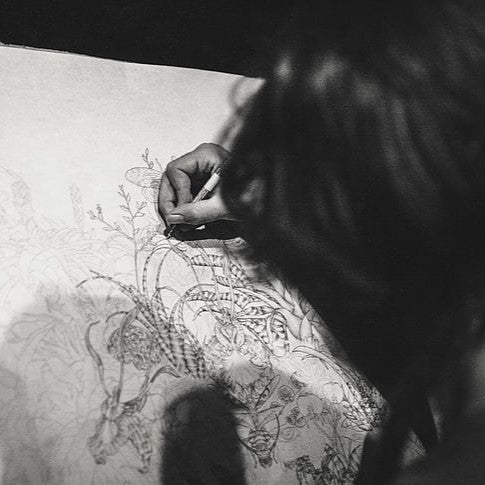6 Ways in Which Art Fosters Healing



Recently a friend was telling me about her pre-teen’s struggles with anxiety. Like many parents concerned with their child’s mental health, she was on the hunt for effective ways to help her daughter cope. She found a child therapist who utilizes art as a means for her clients to express themselves and cope with difficult feelings, and my friend shared that the results have been very encouraging, helping to alleviate some of her child’s stress and anxiety.
There are many ways that art can be used for healing, both as a hands-on creative application as well as through the experience of art in a more passive way as the viewer. The resultant benefits include both as an aid in physical healing and as a means to address and mediate mental health struggles. The evidence of its effectiveness isn’t just anecdotal. There are reputable studies that measure the brain’s activity in response to art stimulus indicating positive impacts. At the most fundamental level, creating art has been shown to reduce cortisol levels in the brain, creating a sense of relaxation. On the other hand, experiencing art as a viewer can increase serotonin levels, enhancing feelings of happiness and well-being. Viewing art may stimulate neural pathways and encourage new perspectives and how we perceive the world around us.
We are taking a look at some of the various scenarios in which art can provide healing and have discovered many compelling examples. This isn’t an exhaustive list, but some of the more common conditions and effective ways in which art has been utilized for medical and therapeutic purposes.
(Please note that the following is not intended to be a substitute for professional medical advice, diagnosis, or treatment, and does not constitute medical or other professional advice)
1. To Improve Cognitive Functioning
There are many types of medical issues which impact the brain, including traumatic brain injury, strokes, and Alzheimer’s disease. While they all affect cognitive functioning in different ways, as a general rule utilizing art through creative activities may strengthen and stimulate brain function with good rehabilitative results for some patients.
Not only do hands-on art activities develop hand-eye coordination but they may also help to trigger memories. Caregivers and providers have found that patients sometimes use art to convey events from their own life experiences. This may occur through painting, drawing sculpting, or other creative activities. Art therapy can also help with the psychosocial issues that can be a result of brain trauma from a stroke such as anxiety and depression, by stimulating the brain’s reparative capabilities.
2. In the Hospital Setting
When we think of hospital art, thoughtfully curated aesthetics don’t necessarily come to mind, but many hospitals are being more deliberate in their selection of art for its soothing capabilities. There are scientific studies that demonstrate that pleasing art in a hospital setting can improve the patient’s overall experience while in a clinical environment.
There is some debate about which styles of art are best suited for hospital decor, but little disagreement about the calming effects of beautifully adorned artfully decorated spaces, in contrast to dull hospital rooms with blank walls. There is speculation that less challenging and more straightforward art is preferable during times in which people feel physical discomfort due to illness and other forms of injury. Regardless, the benefit of creating more pleasant spaces in hospitals and waiting rooms is without question in promoting healing.
3. Addiction Recovery
In the same way that it is utilized for other afflictions, art therapy can be effectively applied for recovering addicts in order to help them express their emotions, cope with hardships and relieve stress.
For some individuals in recovery, art may be one of many tools deployed in place of the drugs and alcohol which they once used as a coping mechanism. Many addiction centers recognize the positive healing powers of this holistic approach to drug and alcohol recovery. In addition to the patient participating in painting and drawing, these may include music therapy and writing as healthy creative outlets.
4. Managing Anxiety and Depression
Whether situational due to the loss of a loved one or for individuals with a clinical diagnosis, depression, and anxiety can leave people immersed in a sense of darkness, for which art can often provide a healing light.
Depression and anxiety are very common afflictions of modern society, and for some people, a holistic approach such as art therapy can provide some relief. Art therapy can provide healing in the form of stress release, positive distraction, and self-discovery for those who live with depression. Art can be helpful in diagnosis as well, and a skilled therapist can often recognize symbolism within art which may be common indicators of depression.
The experience of art can help us better understand death and assist in the grieving process. Art has been used by people of all ages to express sorrow and as a way to sort through the emotions of traumatic loss. Some families have found healing value in commissioning a work of art depicting a loved one who has passed in order to embrace their memory.
5. Coping With PTSD
Iraq War veteran Curtis Bean went on a journey of self-discovery in the years following his tour of duty. He began painting and realized the healing implications it had for his post-traumatic stress disorder as a result of seeing and experiencing the hardships of war. It was such a valuable restorative tool for Bean that he reached out to his local VFW in Denver and collaboratively created art programming to help other veterans dealing with PTSD.
6. As a Tool for Child Therapy
Perhaps one of the most common forms of art therapy, kids have been shown to benefit greatly from this type of therapeutic care. Art therapy practices have been effectively applied in working with kids with Attention Deficit Hyperactivity Disorder, autism, and other disabilities, as well as those who have experienced trauma.
Children are encouraged to draw, paint and color in a facilitated manner by a trained therapist as a mechanism to share the details of a traumatic event, for example. Additionally, art therapy can be incredibly effective as a way to help a child work through difficult feelings and painful experiences.
We hope you’ve gained insight into some of the many ways that art can provide healing. You can explore UGallery’s collections of original art, many of which are focused on peace and optimism, and check out new art weekly on our website.





